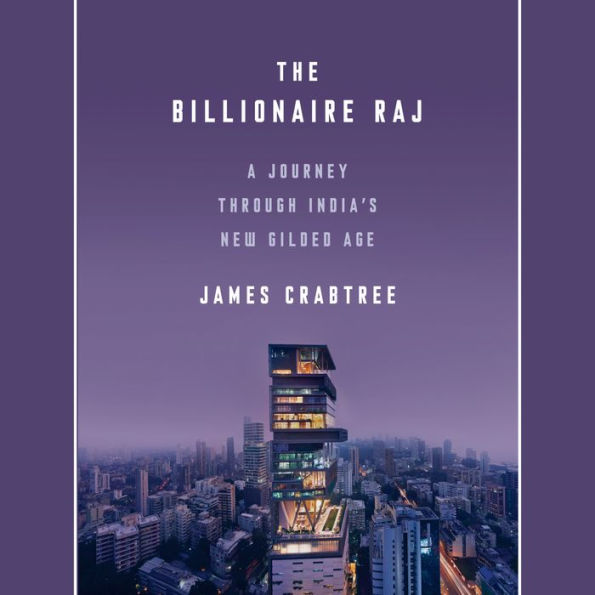The riches of India's prominent families are magnified because they exist alongside the abject poverty of the masses. Narrator Shridhar Solanki's tenor voice casts a questioning tone on their lifestyles and a system that allows so much wealth inequality. He presents to us the author’s anecdotes and analysis of India's billionaires in a storytelling style that makes us shake our heads at their excesses all the while learning about families that are not often in the international headlines. Solanki captures Crabtree’s incredulity at six-story garages and police cover-ups for the wealthy. Listeners are taken by their ears into a world of glittering privilege available only to the truly elite. M.R. © AudioFile 2018, Portland, Maine
A colorful and revealing portrait of the rise of India's new billionaire class in a radically unequal society
India is the world's largest democracy, with more than one billion people and an economy expanding faster than China's. But the rewards of this growth have been far from evenly shared, and the country's top 1% now own nearly 60% of its wealth. In megacities like Mumbai, where half the population live in slums, the extraordinary riches of India's new dynasties echo the Vanderbilts and Rockefellers of America's Gilded Age, funneling profits from huge conglomerates into lifestyles of conspicuous consumption. *
James Crabtree's The Billionaire Raj takes readers on a personal journey to meet these reclusive billionaires, fugitive tycoons, and shadowy political power brokers.*From the sky terrace of the world's most expensive home to impoverished villages and mass political rallies, Crabtree dramatizes the battle between crony capitalists and economic reformers, revealing a tense struggle between equality and privilege playing out against a combustible backdrop of aspiration, class, and caste.
The Billionaire Raj*is a vivid account of a divided society on the cusp of transformation-and a struggle that will shape not just India's future, but the world's.
1127503789
India is the world's largest democracy, with more than one billion people and an economy expanding faster than China's. But the rewards of this growth have been far from evenly shared, and the country's top 1% now own nearly 60% of its wealth. In megacities like Mumbai, where half the population live in slums, the extraordinary riches of India's new dynasties echo the Vanderbilts and Rockefellers of America's Gilded Age, funneling profits from huge conglomerates into lifestyles of conspicuous consumption. *
James Crabtree's The Billionaire Raj takes readers on a personal journey to meet these reclusive billionaires, fugitive tycoons, and shadowy political power brokers.*From the sky terrace of the world's most expensive home to impoverished villages and mass political rallies, Crabtree dramatizes the battle between crony capitalists and economic reformers, revealing a tense struggle between equality and privilege playing out against a combustible backdrop of aspiration, class, and caste.
The Billionaire Raj*is a vivid account of a divided society on the cusp of transformation-and a struggle that will shape not just India's future, but the world's.
The Billionaire Raj: A Journey Through India's New Gilded Age
A colorful and revealing portrait of the rise of India's new billionaire class in a radically unequal society
India is the world's largest democracy, with more than one billion people and an economy expanding faster than China's. But the rewards of this growth have been far from evenly shared, and the country's top 1% now own nearly 60% of its wealth. In megacities like Mumbai, where half the population live in slums, the extraordinary riches of India's new dynasties echo the Vanderbilts and Rockefellers of America's Gilded Age, funneling profits from huge conglomerates into lifestyles of conspicuous consumption. *
James Crabtree's The Billionaire Raj takes readers on a personal journey to meet these reclusive billionaires, fugitive tycoons, and shadowy political power brokers.*From the sky terrace of the world's most expensive home to impoverished villages and mass political rallies, Crabtree dramatizes the battle between crony capitalists and economic reformers, revealing a tense struggle between equality and privilege playing out against a combustible backdrop of aspiration, class, and caste.
The Billionaire Raj*is a vivid account of a divided society on the cusp of transformation-and a struggle that will shape not just India's future, but the world's.
India is the world's largest democracy, with more than one billion people and an economy expanding faster than China's. But the rewards of this growth have been far from evenly shared, and the country's top 1% now own nearly 60% of its wealth. In megacities like Mumbai, where half the population live in slums, the extraordinary riches of India's new dynasties echo the Vanderbilts and Rockefellers of America's Gilded Age, funneling profits from huge conglomerates into lifestyles of conspicuous consumption. *
James Crabtree's The Billionaire Raj takes readers on a personal journey to meet these reclusive billionaires, fugitive tycoons, and shadowy political power brokers.*From the sky terrace of the world's most expensive home to impoverished villages and mass political rallies, Crabtree dramatizes the battle between crony capitalists and economic reformers, revealing a tense struggle between equality and privilege playing out against a combustible backdrop of aspiration, class, and caste.
The Billionaire Raj*is a vivid account of a divided society on the cusp of transformation-and a struggle that will shape not just India's future, but the world's.
22.5
In Stock
5
1

The Billionaire Raj: A Journey Through India's New Gilded Age

The Billionaire Raj: A Journey Through India's New Gilded Age
FREE
with a B&N Audiobooks Subscription
Or Pay
$22.50
22.5
In Stock

Editorial Reviews
Product Details
| BN ID: | 2940172052552 |
|---|---|
| Publisher: | Penguin Random House |
| Publication date: | 07/03/2018 |
| Edition description: | Unabridged |
Videos

From the B&N Reads Blog
